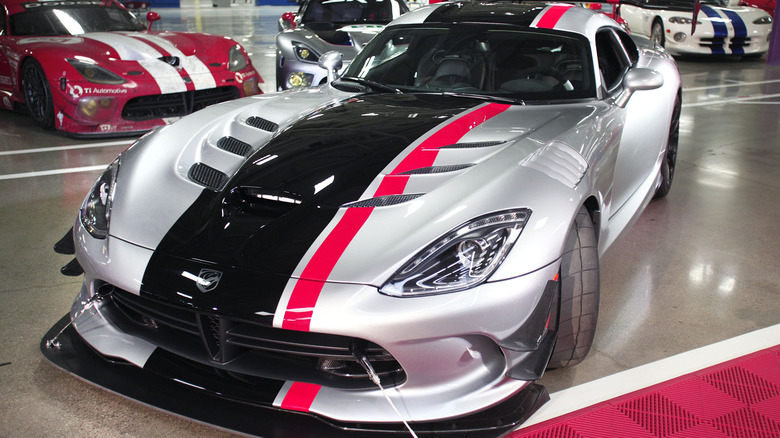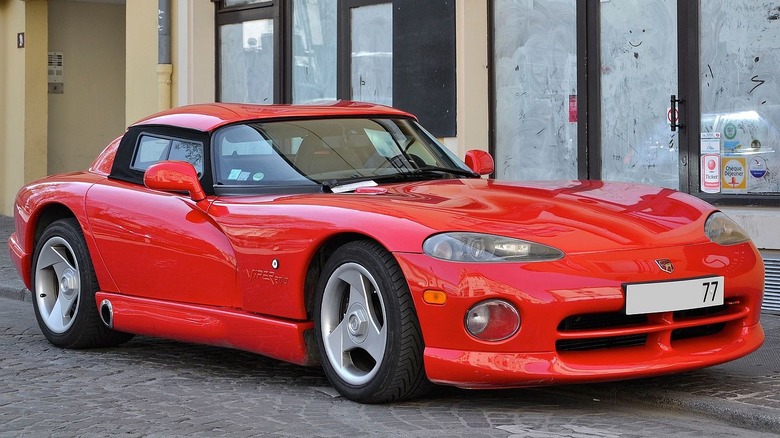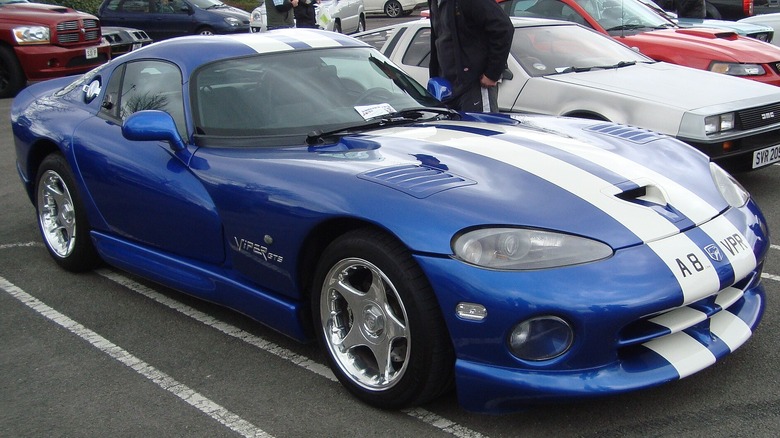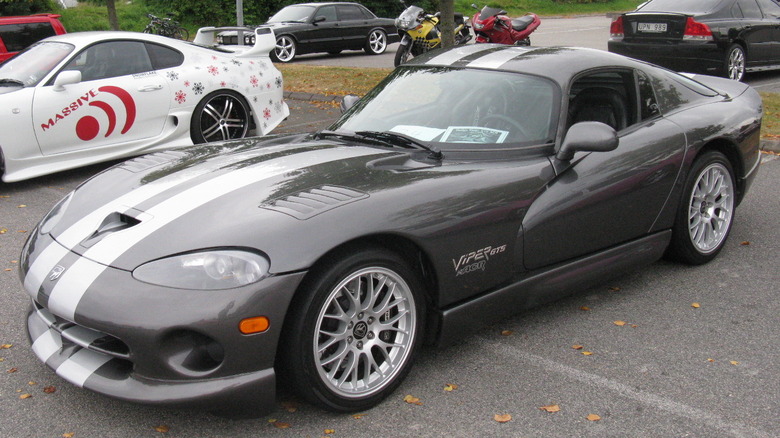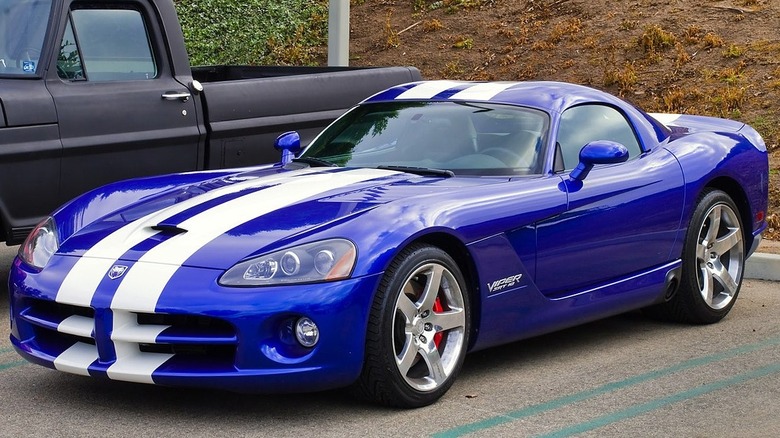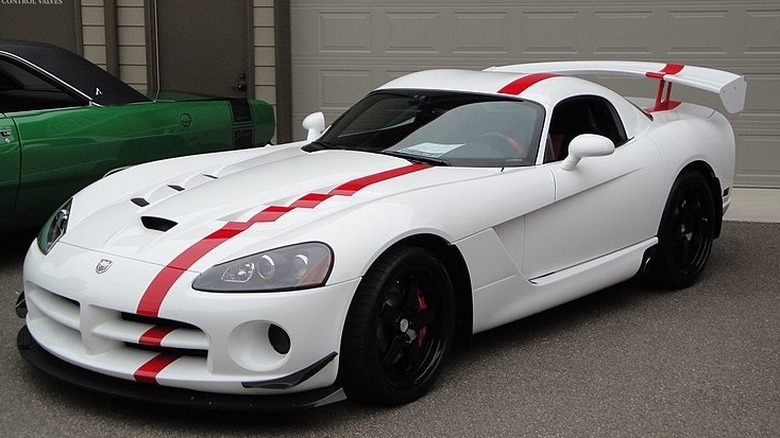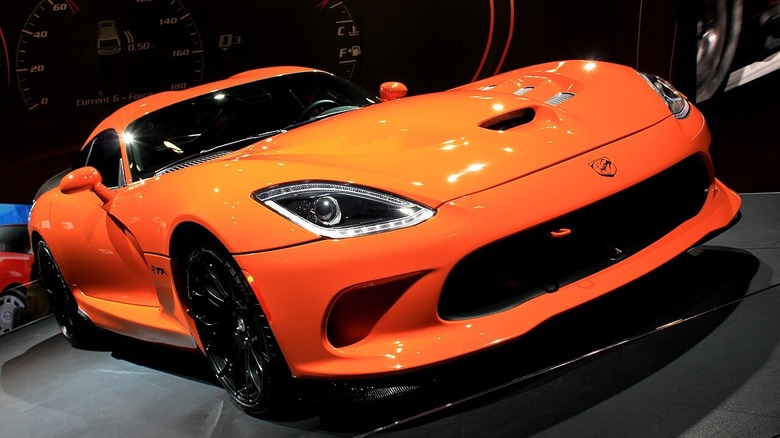Every Generation Of Dodge Viper, Ranked Slowest To Fastest
The Viper. The name evokes a predatory serpent's snap — capable of overpowering but waiting to strike. Few finer names suit Dodge's outrageous supercar killer. The Viper is low to the ground, unpredictable, and can strike at any time if you're not careful. It's no surprise that it's loosely related to the Shelby Cobra, another icon of American performance.
The Cobra is loud, rude, cantankerous, and originals fetch insane prices. With its rarity, many still wonder how many Shelby Cobras were made and what their value is today. When Chrysler president Bob Lutz spent time with his Autokraft Mk IV Shelby Cobra replica, he likely didn't suspect he was on the verge of birthing a legend.
In the 1980s, Chrysler was struggling. Kept afloat by a government bailout in 1980, the K-platform brought in money with its front-wheel drive practicality. But the idea Lutz brought to design chief Tom Gale was a wild departure. He wanted a Chrysler Cobra, a bare-bones race car in the spirit of Carroll Shelby's legendary machine.
The car delivered by Team Viper in 1992 was striking, powerful, and quickly garnered an instant fan base, launching 25 years of Dodge Viper production. Though an onslaught of absurdly powerful Hellcats – powered by Dodge's Hellcat and Hellephant engines — ultimately contributed to its demise in 2017, the Viper's legacy of American sport muscle remains.
In honor of the Viper's vicious vibe, we rank every generation of Dodge Viper from slowest to fastest based on the mighty quarter mile.
6. 1992-1995 SR I Viper RT/10 0-60 mph 4.4 seconds
The Viper hit the scene with a splash. The inaugural Viper served as the pace car at the 1991 Indianapolis 500. It wasn't supposed to debut yet, but the United Auto Workers wanted the American-built Viper out front instead of the planned Japanese-built Dodge Stealth.
The buzz generated at Indy translated to the excitement surrounding the SR1's coming-out party at the 1992 Detroit Auto Show. Dubbed the R/T 10 after its fire-breathing V10 engine and the "road and track" performance cars of Mopar's muscle era, the new meanie on the block maintained a singular focus on power –- at the expense of basic features the original Dodge Viper didn't have.
Who needs air conditioning and door handles? This was a Shelby-inspired racer down to its beastly powerplant, a 488 cubic-inch (8.0 liter) V10 making 400 hp and 450 lb-ft of torque. Occasionally maligned as a truck engine, the truth was that its lineage was far more pure.
Chrysler built the Viper's V10 engine on an aluminum-blocked V8 and brought back engineer Dick Winkles from Italy, where he worked on V10 engines for Chrysler-owned Lamborghini.
The long and short of it is that the first-gen Viper put up numbers. A zero-to-60 mph time of 4.4 seconds and a 13.1-second quarter mile put the American upstart in the same league as names like Diablo VT and F40.
[Featured image by Alexandre Prévot via Wikimedia Commons | Cropped and scaled | CC BY-SA 2.0]
5. 1996-2002 SR II Viper GTS 0-60 mph 4.2 seconds
The Viper may have caught up to foreign exotics in its original incarnation, but the Chevrolet Corvette had the most to lose. America's favorite supercar-killing daily driver suddenly had serious competition, and Dodge knew it. They leaned in by smoothing some rough edges of the SR I.
The R/T 10 would live on until 2002, but the headline for 1996 was the introduction of the GTS. The R/T was a pure roadster, while the GTS arrived late in the model year, introducing a little (and we mean little) sophistication to performance's most spartan vehicle. The SR II came with some goodies the SR I lacked. Posh luxuries like real glass power windows, airbags, missing door handles, and, yes, even air conditioning.
Creature comforts were just a sideshow. The GTS packed 450 hp and 490 lb-ft of torque — a significant improvement over the SR I and more powerful than the SR II R/T 10. Chevy could certainly feel the heat. Even the debut of the 345 hp C5 in 1997 couldn't keep up, though with a $37,495 MSRP well below the GTS' $66,000, one wouldn't expect it to.
The upshot was an evolving SR II Viper that could pull a 4.2-second zero-to-60 time and a 12.3-second quarter mile. Price considerations aside, the SR II GTS was in a league of its own.
[Featured image by Kieran White via Wikimedia Commons | Cropped and scaled | CC BY-SA 2.0]
4. 1999 SR II Viper ACR 0-60 mph 4.2 seconds
There is a little footnote to the SR II Viper, the American Club Racing version, better known to Viper honks as the ACR. While technically an SR II GTS, we include it here as its own mini-generation thanks to Dodge's sometimes confusing generational jargon (more on that below).
The ACR was created as an homage to the GTS-R Viper, which won the 1998 FIA GT2 trophy as part of Team Oreca. If nothing else, the winner proved that the Viper was not some simple, straight-line beast but a proper racing car.
Dodge wanted the ACR to reflect its heritage, so it stripped as much weight as possible by removing anything extraneous. They tore out the fog lights, speakers, stereo, and, unsurprisingly, the air-conditioning. The resulting 60-pound weight reduction and a bump in hp to 466 thanks to some tweaks to the air intake made the first ACR special, even if it would never qualify as a road-trip queen.
Even with the improvements, the 1999 Viper ACR barely edges out the GTS. It retains the same zero to 60 speed with a 4.2-second run, but every ounce counts. The ACR bested the GTS by a mere two-tenths of a second with a 12.1-second quarter mile.
[Featured image by nakhon100 via Wikimedia Commons | Cropped and scaled | CC BY 2.0]
3. 2003-2007 ZB I Viper SRT10 0-60 mph 4.0 seconds
The SR I and SR II Vipers share fundamental chassis underpinnings, making the difference between the first two "generations" more like facelifts (with some performance tweaks) rather than complete overhauls. In 2003, the Viper got its first new chassis code, ZB I. The acronyms and designations get a little murky, but it's best to think of 2003 to 2007 Vipers as a third-generation vehicle.
The Viper of the early 1990s had already established itself, giving the SRT10 enormous shoes to fill. Dodge's vaunted Street and Racing Technology division got in on the fun for the ZB 1. After bidding goodbye to the R/T 10, the SRT10 arrived in 2003 in coupe and roadster versions. A displacement increase from 488 to 500 cubic inches (8.3 liters) spawned the rule of 500, with the SRT division targeting one hp and one ft-lb torque per cubic inch.
With 500 hp and 500 ft-lb torque from a new engine, Tremec six-speed transmission, and Brembo brakes, the ZB I could stop nearly as well as it could go. It was still a Viper, a little uncouth, though Car and Driver's original test drive praised it for a "sense of complete integration in the whole car."
Integrated or not, the new version was faster than its predecessor yet again, with a 3.8-second zero-to-60 time and an 11.8-second quarter mile.
[Featured image by Pat Durkin via Wikimedia Commons | Cropped and scaled | CC BY-SA 2.0]
2. 2008- 2010 ZB II Viper SRT10 0-60 mph 3.5 seconds
The ZB II Viper is usually considered a fourth generation, though it still relies on a modified version of the ZB I chassis. It was the shortest-lived Viper gen, seeing production between 2008 and 2010 before the nameplate took a hiatus.
Still a product of SRT, the new Viper upped displacement a tad to approximately 513 cubic inches (8.4 liters), thus blowing the rule of 500. But it did not matter because the new model put out 640 hp and 600 lb-feet of torque. It still had the Corvette on the run, producing more torque at 2,500 RPM than that year's Z06 made at its full power.
Some new technological baubles improved performance, including a speed-sensing limited-slip differential and rack-and-pinion steering that helped improve the Viper's historically poor reputation for understeer. Anti-lock 14-inch Brembo brakes were Dodge's only recognition that traction control systems were things that existed. Still, the sum of the package was a car praised for lack of jitteriness, even at high speeds or during violent acceleration.
Like most good sports cars, the penultimate Viper outperformed the previous generation, besting the ZB I by a hair with a record zero-to-60 time of 3.5 seconds while achieving the same 11.6-second quarter mile.
[Featured image by Greg Gjerdingen via Wikimedia Commons | Cropped and scaled | CC BY-SA 2.0]
1. 2013-2017 VXI SRT Viper 0-60 mph 3.3 seconds
After a brief hiatus, the final form of the Dodge Viper hit the scene in 2014 as a completely redesigned vehicle. The engine was all aluminum, sticking with the same 513 cubic-inch (8.4 liter) V10. It included forged pistons, a composite intake manifold, and a lightweight construction that shaved an incredible 25 pounds (11 kg) off the engine's weight alone, making the Dodge Viper V10 engine special.
Hand-built, the fifth-gen had an all-new chassis codenamed the VX I that improved torsional rigidity by 50%, an X-brace that spanned the engine compartment, and a re-engineered rear suspension that added stability. For the first time ever, Dodge bowed to the times by including a selectable suspension system with Street and Track settings. I guess they didn't get the memo that in a Viper, every street feels like a track.
The last Viper beat all previous generations in the speed game with a 3.3-second zero-to-60 and an 11.5-second quarter mile, but it ultimately became the victim of its own success.
The original SR I Viper brought Chrysler back into the performance fold. From the original team that put the prototype together sprung the seeds of what would become SRT, and from thence came the Hellcat Chargers and Challengers that would eventually outclass the Viper in Dodge's never-ending quest for absurd power.
[Featured image by Joseph Brent via Wikimedia Commons | Cropped and scaled | CC BY-SA 2.0]
Methodology
There is more than one way to measure speed, but no matter the method, any given day or track condition can see the speeds at which a car performs waver by a few seconds one way or the other. Deciding on the proper measure for a performance vehicle is somewhat subjective. Should you judge a top fuel dragster by its time around Laguna Seca? How about a Porsche in a rally race (okay, not the best example)?
In the past, the Viper has caught some flak as a big, dumb, straight-line V10 monster that would throw a piston rod across the Atlantic Ocean if the engine ever blew. In honor of the quintessential Americanness of the Viper and its entire ethos, we've ranked it by America's favorite racing statistic: the quarter-mile time.
Going fast in a straight line is not the only thing the Viper can do, but it is one of its greatest strengths. Measuring it by any other standard would be an insult.
